BMW engine boosts Supra to new Toyota image
By John Gilbert
The idea that folks at Toyota are going through a “second childhood” takes root from the fact that the Japanese auto giant has hit the market with several sports coupes, convertibles and racy vehicles in the last few years. The upscale Lexus LC500 was the subject of my review here just a few weeks ago, as the 6-figure pinnacle of luxury-performance, and now, before October gets far enough along to threaten us with some foul weather, we’ve got to also check out the 2021 Toyota Supra and declare it the company’s bargain luxury-sports car.
Actually, the bargain sports car of the Toyota line is the unfortunately-named Toyota 86, an under-$30,000 sports car built jointly with Subaru, using Subaru engines, and almost identical to the Subaru BRZ.
The new Supra is a completely different story. If working a jont-venture with Subaru was a good idea for a low-slung sports car, then working the magic combination with BMW to come up with the Supra is even better, and a mid-$50,000 price point is a comparative bargain when you know you’ve got the same 3.0-liter inline 6 made by BMW for its new M4 sporty coupe.
The Supra is a grand old name in Toyota lore, starting as a stretched out luxury model of the Celica coupe three decades ago, and it persisted as a powerful sporty cruiser with a potent Toyota in-line 6 and all of the company’s advancing technology. Toyota even stretched the Supra out into a “2 plus 2” model with a jump-seat behind the two buckets.
Times change, and with its new upscale Lexus brand also needing vehicles, the Supra disappeared from the U.S. market just over 20 years ago. Toyota now is on a movement to shed its stodgy, conservative image, and after its Lexus sports cars and sportier leaning of Toyotas, the company brought back the Supra name on an exotic-looking new sports coupe as the fifth-generation Supra for 2020.
The look of the Supra didn’t dazzle men when it first came out for 2020. I knew it was something of a composite vehicle jointly created by Toyota and BMW, giving it legendary heritage from two international automotive legends. But it had this extra-prominent nose that I thought made it look, well…ugly.
Anyhow, after a few slight revisions, a 2021 model of the Supra showed up for me to test drive, up and down the North Shore of Lake Superior in mid-September, just before the leaves were turning color, and it was a pure, bright red attention-grabber. So, too, were the grooves and scoops and contours that pretty well obscured the nose. The nose! What happened to the nose? The prominent beak was modified to the point its nose is no longer is objectionable, in my humble opinion, and you can judge for yourself from the accompanying photos.
Similar in size and intention to the LC55 Lexus, which cost somewhere north of six figures, I was pleasantly surprised to find the Supra was more like the mid-$52,000 range, which is definitely a bargain, by comparison.
Under the hood is a 3.0-liter inline 6, which could have been built by Toyota in the old days, but is built by BMW today, and certainly not a bad choice. Traditional sports car buyers will appreciate the rear-drive platform, although I could foresee all-wheel drive in the future.
This twin-turbocharged 6 delivers 382 horsepower and 368 foot-pounds of torque through an 8-speed transmission, directly to the rear wheels. The car handles with great precision, with a platform also from BMW’s engineers. You can play with the drive mode switch and get into sports settings that heighten the stiffness and the tightness of the steering and suspension, and turns the exhaust from mellow to raucous.
There are a couple of drawbacks. One is that while the bucket seats comfortably engulf your body once seated inside, getting inside is another matter. Toyota should offer a racy-looking helmet with every Supra — not because you are going racing, but to protect you from a concussion if you try to “hop in.” You climb in at your own risk, with one foot first and then a contortionist’s elasticity, or — my choice — you back in, lowering your backside until you feel that seat cushion, then you bend, fold and mutilate your legs up and in, as you try to also bring your head inside.
Whap! That’s where I dislodged my baseball cap every time, which wasn’t a problem, compared to the thunk of your head hitting the roofline. After a few tries, I got better at it, by not wearing a cap, and by scrunching my head down and back to squeeze it in without contract.
Getting out is actually easier, because you throw open the door, lean your head out, and then attempt to vault the rest of your body up and out. The thing is, while a whole exercise routine could be coordinated into getting in and out, it’s so impressive to be inside the Supra, you might just decide to stay in there and minimize how frequently you have to get in or out.
Instrumentation is clear and concise and easy to read, although setting the audio controls takes some doing. The Supra is another in the recent trend of vehicles that seems to have overlooked the convenience of a simple, easy-to-use audio system. Such ease of operation is increasingly important to potential buyers in their decision-making process. I would never advocate making a decision based on such a marginal thing, but convenience is no longer marginal, not when some companies make simpler controls.
All of the contemporary safety devices are on board, including front, rear and side detectors with cautioning alarms, and assistance to help you stay in your lane or not to pull into an adjacent lane if something is there.
The attraction of the Supra is readily evident to anyone driving it for only a few days. I pulled into a gas station and when I climbed out to get to the pump, I heard someone say, “Nice car!” I turned around and located the fellow who added, simply, “Supra?”
Yes, I told him, but I felt compelled to acknowledge that it wasn’t my car, but a factory test-drive vehicle that I got to test-drive for that week. The fellow decided I had the greatest job in creation, because I could drive such spectacular cars but didn’t have to pay for them. I explained how the process works, and that I wrote an analysis of the cars I get each week, but that, yes, it is a pretty special and much-appreciated opportunity.
Another young fellow driving a car he has spent special attention tuning up pulled off the main road and into a parking lot abruptly when he drove past my parked Supra. He jumped out, leaving his door open, and hustled over to give the car a close-up examination. Something similar happened nearly every time I stopped or parked the Supra.
With everything on the test-car, the price was nearly $55,000, but that’s still only about half of what the more luxurious Lexus LC500 sticker read, nd the performance of that turbo-6 can challenge any other sports car.
The benefit of BMW precision in the platform and in the responsiveness of the 3.0-liter engine, singing its turbocharged song up through the rev-range is impressive. Paddle shifters help, although I found the 8-speed automatic upshifted and downshifted with surprisingly well-timed shifts.
You’re reminded of that BMW performance heritage every time you choose to paddle shift up there around 7,000 RPMs, which is where the engine computer shuts off the fuel flow. That’s plenty high, and enjoyable. Even without engaging the sport mode, the steering and suspension helps you always go where you’ve urged the Supra to go, with no harshness interrupting the pleasantly stiff platform and the harmonious suspension and steering.
There might have been complaints from rear-seaqt occupants — except there is no rear seat, just a small platform to toss a jacket or camera case under the rear window.
There are a few other suggestions I would make to Toyota, after driving the car for a week, aftger figuring out a way for drivers who might be 6 feet tall to bring their heads in with them. And that is to do something about the incredibly annoying wind buffeting. Cruising on a 70-ish day means you needn’t activate your air-conditioning, instead enjoying fresh air by opening your windows.
That works well puttering around urban streets, and helps you hear the neat exhaust sound more, but as you build up revs and get up to, say, 45 miles per hour, you suddenly hear a loud thrumming vibrating through the interior. It is startling enough that I thought I might have blown a tire! If you go a little faster, it gets worse, although it doesn’t seem to be there below 45. My question is that the same company makes that Lexus LC500 convertible, and with the top down, there is no wind buffeting. So they can’t figure out how to solve this? C’mon.
With all the computerized driving techniques available these days, Toyota not only tweaked the appearance of the Supra a bit, but it also went underneath and returned the adaptive steering, the rate of adaptive variable suspension, and the programming for the stability control.
Another wonder of the Supra is that with all those electronic things collaborating to keep you driving and steering precisely, you have no idea it’s all there. You just know it goes where you point it, and swiftly.
When I did get out for refueling, it asked for 91 octane (premium). As I’ve often suggested, that is something to take into account when purchasing a car, because gas stations nowadays seem unflinching when they price premium fuel at 60 cents more per gallon. I got 28 or 29 miles per gallon in combined driving, heavy on city streets and hills, with liberal doses of acceleration, just because it was fun. But if you stop and calculate how much more you’ll have to pay for a month or a year of fuel refills, a regular-burning sporty vehicle makes a lot of sense.
The Supra is also offered for 2021 with a 2.0-liter turbocharged 4, which will get good power and better fuel economy. Might be worth checking.
Still, if Toyota wanted a sports car that brings to life the heritage the company seemed to abandon 21 years ago, bringing back the Supra for a fifth generation, with an inline 6 that adds BMW prestige to the picture, the 3.0 Supra deserves all the attention a buyer can summon.


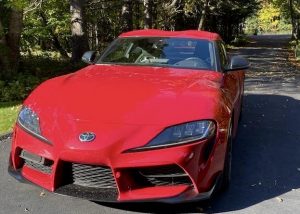
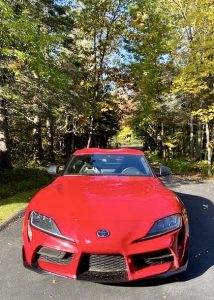
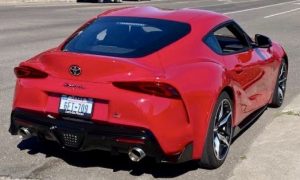
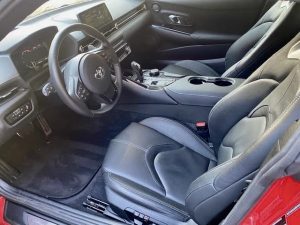
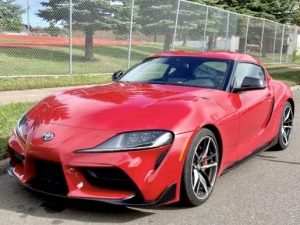
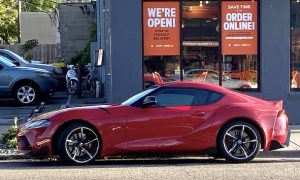
 John Gilbert is a lifetime Minnesotan and career journalist, specializing in cars and sports during and since spending 30 years at the Minneapolis Tribune, now the Star Tribune. More recently, he has continued translating the high-tech world of autos and sharing his passionate insights as a freelance writer/photographer/broadcaster. A member of the prestigious North American Car and Truck of the Year jury since 1993. John can be heard Monday-Friday from 9-11am on 610 KDAL(www.kdal610.com) on the "John Gilbert Show," and writes a column in the Duluth Reader.
John Gilbert is a lifetime Minnesotan and career journalist, specializing in cars and sports during and since spending 30 years at the Minneapolis Tribune, now the Star Tribune. More recently, he has continued translating the high-tech world of autos and sharing his passionate insights as a freelance writer/photographer/broadcaster. A member of the prestigious North American Car and Truck of the Year jury since 1993. John can be heard Monday-Friday from 9-11am on 610 KDAL(www.kdal610.com) on the "John Gilbert Show," and writes a column in the Duluth Reader.